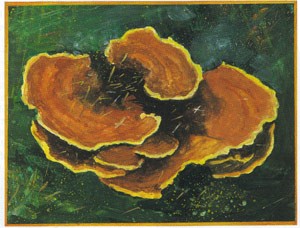
The fungi that attack heartwood in living trees are grouped according to what part of the tree they attack – roots, butt, trunk, or branches – and by what component of the wood they consume. Some species consume more lignin than cellulose, leaving stringy, whitish, rotten wood, and these are called white rotters. Brown rotters, in contrast, degrade cellulose, leaving rotten brown wood that breaks into cubes. The velvet top fungus is a brown root and butt rotter – a name about as unappetizing as Phaeolus schweinitzii.
It’s in late summer or early autumn that the presence of velvet top fungus is usually first noticed, for it is then that its fruiting bodies appear, most often on the ground and within a short distance of the trunk of a white pine or spruce. These basidiocarps, as the mushrooms in this large group of fungi are called, are more or less circular, sunken towards the center, and up to 10 inches across. When first formed, the outer rim is yellow, and the concentric inner rings are typically reddish, greenish, or yellow-brown. The fungus is used for making rich, brown dyes, and another name for it is dyer’s polypore.
A velvet top fruiting body tends to be quite wet and squishy, often dripping water. The underside has irregular pores, is greenish when new, and turns red-brown when bruised. As a velvet top ages, the whole thing becomes brittle, turns brown, and looks like a cow pie. Sometimes the fungal infection is in the butt of a tree, and then the basidiocarps are stemless bracket conks that emerge directly from the trunk. More often, it is the roots that are infected, and the mushrooms grow from the ground on short stalks.
When the basidiocarps are young and fresh, the top surface is truly velvet-like, and the colors are rich and clear. From late summer until frost, spores are released in vast numbers from the large surface area of the tiny, packed-together pores.
It is one of the commonest root- and butt-rotting fungi, and many conifer species in North America and throughout Eurasia are susceptible. Spores that fall on the ground can cause persistent infestations in the soil, and these have been found even where there is no root rot. Typically, a tree becomes infected when a spore enters at a wound. Soil compaction, flooding, fire, wounds, and other stresses seem to predispose a tree to this disease.
Velvet top fungus has been thought of as a disease of the elderly, but in fact, trees of any age can become infected. Young trees get in trouble most often when they are growing on an unsuitable site. The telltale fruiting bodies may not show up for many decades, and there are no other visible symptoms – unless, of course, the tree breaks or is uprooted. Trees with decayed roots are often toppled over. A broken-off trunk may result if the fungus has spread throughout the heartwood in the butt of a tree. By the time the fungus fruits and is visible from the outside, there is substantial decay within.
Although it is possible that velvet top fungus travels from tree to tree, this is considered unusual. Diseased trees are more often scattered than grouped, and when adjacent trees are infected, they contain different clones of the fungus. If the fungus had moved from one tree to another, you would expect to find the same clone in both trees.
In laboratory tests in which blocks made up of agar and spruce sawdust were inoculated simultaneously with several different fungi, velvet top came out as the one most able to outgrow its competitors. Even so, the decay it causes is confined to the heartwood and usually is in roots or, if in the trunk, is within 10 feet of the ground. Like other heartwood fungi, it cannot penetrate a healthy, wound-free tree’s defenses and is not able to make inroads in sapwood, where nutrients and water are transported. Only rarely does it kill standing trees.
From a forest ecosystem point of view, this tree-toppler is beneficial. By decomposing wood, it slowly releases minerals and nutrients so that they can be taken up by other forest organisms, including the next generation of trees.

